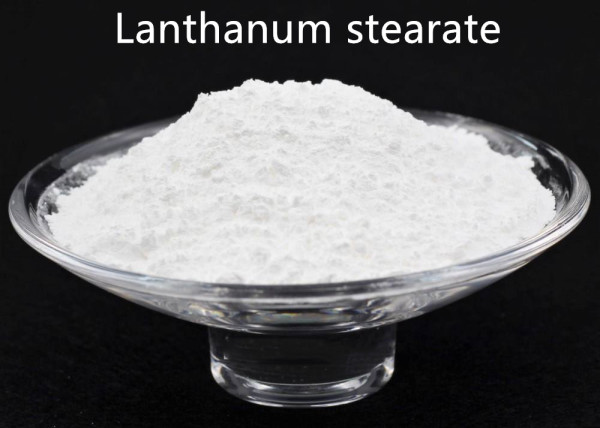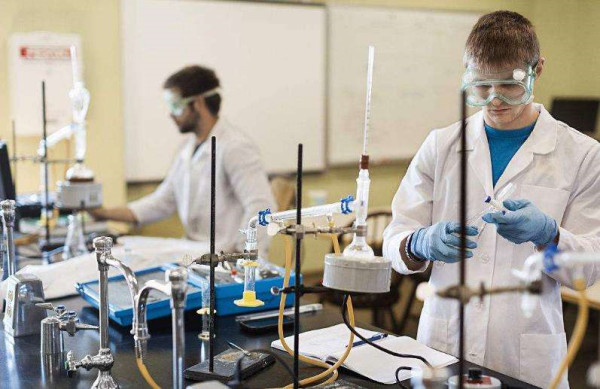Lanthanum stearate is a new type of polyvinyl chloride (PVC) thermal stabilizer that replaces metal soap salts. The traditional method of synthesizing lanthanum stearate is a metathesis reaction method. The product obtained by this method contains inorganic salt impurities. To disperse stearic acid and sodium stearate, a large amount of water is used as a solvent, so the equipment is large, the energy consumption is high, and the water consumption is high. So is there a way to directly synthesize lanthanum stearate? This article will explore the feasibility of directly integrating lanthanum stearate. The oxide used in the experiment is lanthanum oxide (La2O3). To prevent the product from containing chloride ions, so as not to catalyze the decomposition of PVC, nitric acid was selected when the acid was dissolved. To overcome the disadvantage of stearic acid being insoluble in water, a small amount of ethanol was used as a solvent. Considering that many factors are affecting the synthesis process, to reduce the number of experiments and obtain the most suitable process conditions, an orthogonal experiment method is used.

Experimental part
1.Raw material
Stearic acid (HST), lanthanum oxide (La2O3), industrial products, solid alkali, nitric acid, ethanol, and ammonia are all chemically pure.
2. Experimental method
First, we need to prepare the lanthanum nitrate. Measure 1.63 g (0.05 mol) of La2O3 into a 200 mL beaker, add 8.33 mL of a 1: 3 nitric acid solution, and slowly heat in a fume hood until La2O3 dissolves and the answer is clear. Then dilute with distilled water to the specified concentration to obtain a lanthanum nitrate solution.
Next, we prepare the lanthanum stearate. The reaction formula for preparing lanthanum hard acid is: La (NO3) 3 + 3NH3 · H2O La (OH) 3 ↑ + 3NH4NO3 (1) 3C17H35COOH + La (OH) 3 (C17H35COO) 3La ↑ + 3H2O. Take a clean 500 mL three-necked flask, add 8.52 g (0.03 mol) of stearic acid and an appropriate amount of ethanol as a solvent, put it in a water bath, install the magnetic stirring and dropping funnel, and heat to the specified temperature. Start stirring to dissolve the stearic acid completely. Then add the specified concentration of lanthanum nitrate solution. After stirring well, slowly add the ammonia solution from the dropping funnel, and then keep it to the specified time, and filter while hot.
Finally, the lanthanum content of the product needs to be determined, and the xylenol orange decomposed by nitric acid is used as an indicator, and the EDTA titration analysis is used.

Factors affecting experimental results
1.Effect of reaction temperature on an experiment during the synthesis of lanthanum stearate
The reaction temperature is the most critical factor affecting the yield of rare earth. As the reaction temperature increases, the return of extraordinary earth increases. This is because as the temperature increases, the energy of the reactant molecules increases, the chance of effective collision increases, and the reaction are more complete. Because ethanol is used as the stearic acid solvent in this experiment, the boiling point of ethanol is 78.3 ℃ under normal pressure, so the reaction temperature of about 80 ℃ is appropriate. Excessive heat can easily cause rapid volatilization of ethanol, but the yield will decrease.
2.Effect of Lanthanum Nitrate Solution Concentration on Experiments in the Synthesis of Lanthanum Stearate
As the concentration of the lanthanum nitrate solution increased, the yield of lanthanum increased. When the level reached more than 2.4 mol / L, the yield decreased instead. It may be that the level of the material liquid is too high, which is not conducive to the uniform mixing of the reaction materials. Therefore, it is appropriate to select a lanthanum nitrate feed solution concentration of 2.4 mol / L.
3.Effect of Ammonia Concentration on Experiments during the Synthesis of Lanthanum Stearate
During the reaction, to keep the reaction system from causing excessive alkali and hydrolysis of lanthanum stearate, ammonia was added in a dropwise manner. Because the solvents of ammonia water and lanthanum nitrate are both water, after the water is added, it first forms La (OH) 3 with lanthanum nitrate. It then reacts with stearic acid to form lanthanum stearate. Increasing the concentration of ammonia water is conducive to the reaction. Still, when the level of ammonia water is too broad because ammonia is volatile, it will volatilize when the response is still available in the future, resulting in insufficient ammonia water and reducing the yield. Therefore, the ammonia concentration is preferably 0.8 mol / L.
4.Effect of Stearic Acid Concentration on Experiments during the Synthesis of Lanthanum Stearate
The yield of lanthanum increases with the increase of stearic acid concentration (that is, the decrease in ethanol consumption), which is conducive to cost reduction. However, when the amount of ethanol is small, the viscosity of the reactant increases, which is not conducive to the reaction. Stearic acid concentration should be controlled at about 1.0 mol / L.
5.Effect of reaction time on the experiment of the synthesis of lanthanum stearate
Since this reaction is an acid-base neutralization reaction, the speed is fast. To make the reaction system under weakly acidic conditions, the result is carried out by adding ammonia dropwise. The dropping time is preferably 30 minutes. However, the result did not wholly end after the ammonia was added dropwise, and there must be a holding time. The holding time should be selected as 30 min.




